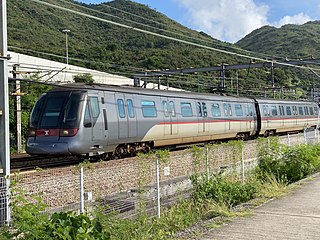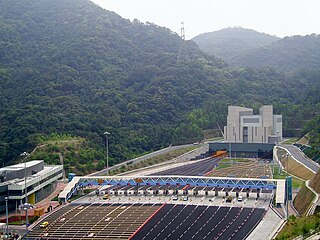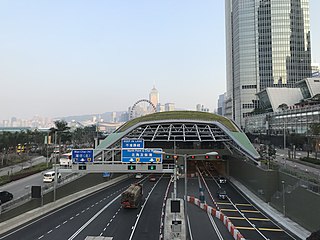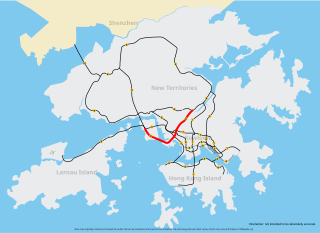
Tsing Ma Bridge is a bridge in Hong Kong. It is the world's 17th-longest span suspension bridge,and was the second longest at the time of its completion. The bridge was named after the two islands it connects,namely Tsing Yi and Ma Wan. It has two decks and carries both road and rail traffic,which also makes it the largest suspension bridge of this type. The bridge has a main span of 1,377 metres (4,518 ft) and a height of 206 metres (676 ft). The span is the longest of all bridges in the world carrying rail traffic.

Tsing Yi,sometimes referred to as Tsing Yi Island,is an island in the New Territories of Hong Kong,to the northwest of Hong Kong Island and south of Tsuen Wan. With an area of 10.69 km2 (4.13 sq mi),the island has been extended drastically by reclamation along almost all its natural shore and the annexation of Nga Ying Chau (牙鷹洲) and Chau Tsai. Three major bays or harbours,Tsing Yi Lagoon,Mun Tsai Tong,and Tsing Yi Bay (青衣灣) in the northeast,have been completely reclaimed for new towns.

Stonecutters Island or Ngong Shuen Chau is a former island in Victoria Harbour,Hong Kong. Following land reclamation,it is now attached to the Kowloon Peninsula.

The Tung Chung line is one of the ten lines of the MTR system in Hong Kong,linking the town of Tung Chung with central Hong Kong. It was built in the 1990s as part of the Airport Railway project,part of the construction of the new Chek Lap Kok Airport. The line currently travels through eight stations in 31 minutes along its route. The line is coloured orange on the MTR system map.

The Lantau Link,formerly known as the Lantau Fixed Crossing,is a roadway in Hong Kong forming part of Route 8 linking Lantau Island to Tsing Yi,from which other roads lead to the urban areas of Kowloon and the rest of the New Territories. Part of the Airport Core Programme centred on the new Hong Kong International Airport on Lantau. The link was officially opened on 27 April 1997,and it opened to traffic on 22 May the same year.

Ting Kau Bridge is a 1,177-metre (3,862 ft) long cable-stayed bridge in Hong Kong that spans from the northwest of Tsing Yi Island and Tuen Mun Road. It is near the Tsing Ma Bridge which also serves as a major connector between the Hong Kong International Airport on Lantau Island and the rest of Hong Kong. It was completed on 5 May 1998. The bridge is toll-free.

Rambler Channel is a body of water in Hong Kong that separates Tsing Yi Island from Tsuen Wan and Kwai Chung in the New Territories. The channel separates the two landmasses by 900 metres at its widest point.

Route 8 of Hong Kong is a dual 3-lane carriageway motorway that links Lantau Island,Tsing Yi Island,Cheung Sha Wan in West Kowloon,and Sha Tin in the southeast New Territories of Hong Kong. It is a combination of many sections.

The South Island line,is a rapid transit line of Hong Kong's MTR metro system. This line connects the Hong Kong business district from Admiralty station to the Southern District of Hong Kong Island and the island of Ap Lei Chau,which was not served by any rail transport prior to the opening of the line. Approved by the Executive Council in 2007,the line commenced service on 28 December 2016. The line is identified by light green on the MTR route map. The rolling stock of the South Island line is purpose-built for driverless operation,with trains being remotely controlled from the Operations Control Centre in Tsing Yi.

Stonecutters Bridge is a high level cable-stayed bridge spanning the Rambler Channel in Hong Kong,connecting Nam Wan Kok,Tsing Yi to Stonecutters Island. The bridge deck was completed on 7 April 2009,and opened to traffic on 20 December that year. The bridge was the second-longest cable-stayed span in the world at the time of its completion.

The Airport Core Programme was a series of infrastructure projects centred on the new Hong Kong International Airport during the early 1990s. The programme was part of the Port and Airport Development Strategy,commonly known as the Rose Garden Project.
Nam Wan Kok is a cape in the southeast corner of Tsing Yi Island,Hong Kong. Its coast was reclaimed and became Container Terminal 9. The Nam Wan Tunnel and Stonecutters Bridge meet there.

Eagle's Nest Tunnel and Sha Tin Heights Tunnel are road tunnels in the New Territories of Hong Kong. Both tunnels were officially opened on 21 March 2008. The tunnels connect Cheung Sha Wan through Eagle's Nest hill to Tai Wai,and are linked by a shared toll plaza. Eagle's Nest Tunnel is connected at its southern end to Stonecutters Bridge and Ching Cheung Road,whereas Sha Tin Heights Tunnel is linked at the northern end to Che Kung Miu Road and Tai Po Road. The tunnels are part of the Tsing Sha Highway of Route 8,and were constructed in anticipation of future traffic demands generated by development in the northeast New Territories. The combined toll for the two tunnels is HK$8.

Tsing Yi Peak,also known as Sam Chi Heung,is a hill with three peaks occupying the southern half of the Tsing Yi Island,Hong Kong. The hill is situated on the western half of Victoria Harbour. Its peaks are good locations to observe the harbour and the channels among harbour islands. While situated in the south,a short hill Liu To Shan occupies the northwest of the island.

The Central–Wan Chai Bypass is a 4-kilometre (2.5 mi) trunk road running between Sheung Wan and Fortress Hill on Hong Kong Island. The original design consists of a 2.3 km dual three-lane tunnel running under new reclamation areas provided by the Central and Wan Chai Reclamation project,and also connections to Connaught Road West flyover and Island Eastern Corridor. It substitutes Connaught Road Central,Harcourt Road,Gloucester Road and Victoria Park Road to be part of Route 4.
Articles related to Hong Kong include:

Tsing Sha Highway is a major expressway in Hong Kong,which links the island of Tsing Yi to Sha Tin. The road is part of Route 8,which starts in Sha Tin and terminates in Tung Chung. It was opened in March 2008 and extended in December 2009.

The Drainage Services Department (DSD) is a department of the Hong Kong Government responsible for drainage and sewerage. Since 2007 it has been subordinate to the Development Bureau.


















